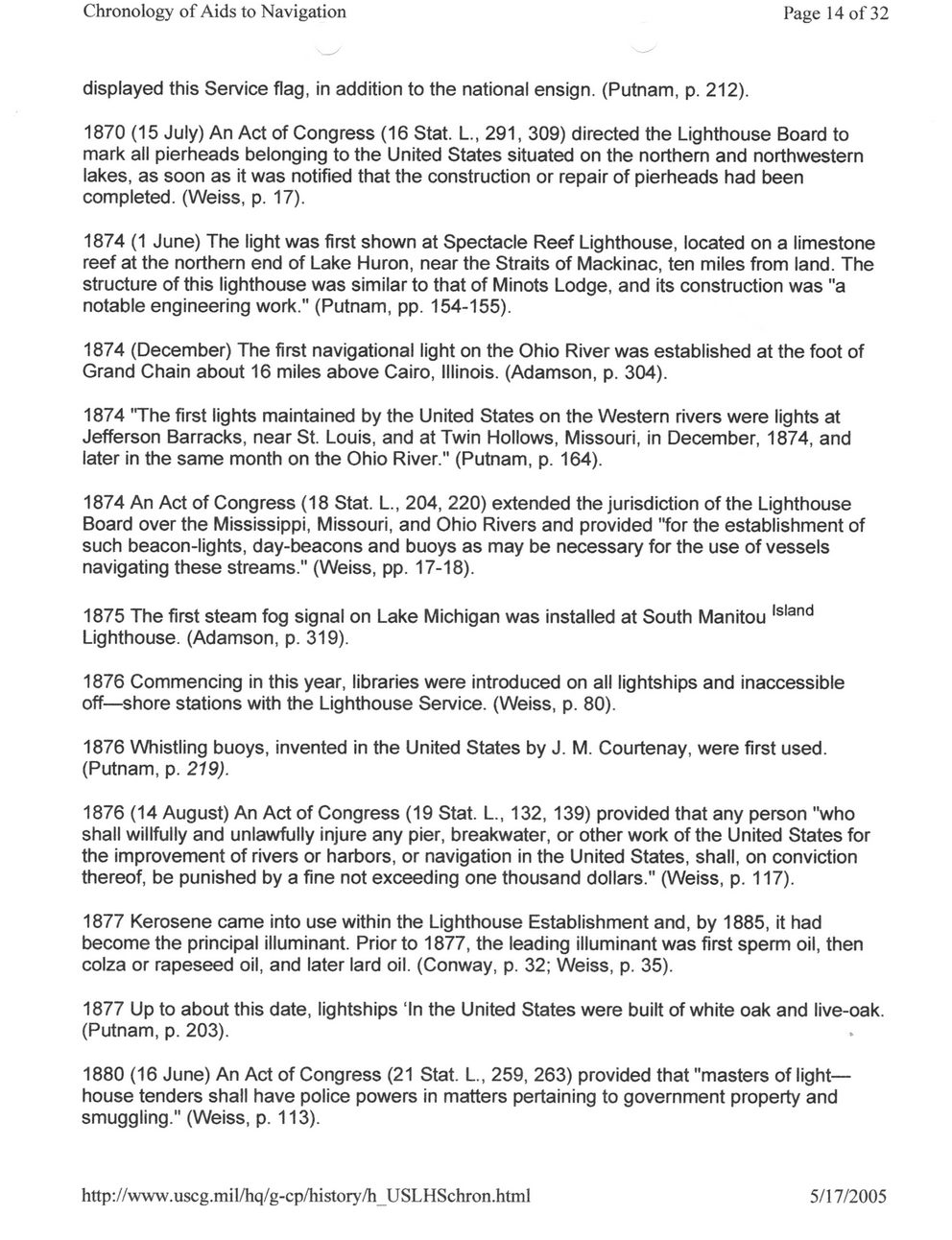This text was obtained via automated optical character recognition.
It has not been edited and may therefore contain several errors.
Chronology of Aids to Navigation Page 14 of 32 displayed this Service flag, in addition to the national ensign. (Putnam, p. 212). 1870 (15 July) An Act of Congress (16 Stat. L., 291, 309) directed the Lighthouse Board to mark all pierheads belonging to the United States situated on the northern and northwestern lakes, as soon as it was notified that the construction or repair of pierheads had been completed. (Weiss, p. 17). 1874 (1 June) The light was first shown at Spectacle Reef Lighthouse, located on a limestone reef at the northern end of Lake Huron, near the Straits of Mackinac, ten miles from land. The structure of this lighthouse was similar to that of Minots Lodge, and its construction was "a notable engineering work." (Putnam, pp. 154-155). 1874 (December) The first navigational light on the Ohio River was established at the foot of Grand Chain about 16 miles above Cairo, Illinois. (Adamson, p. 304). 1874 "The first lights maintained by the United States on the Western rivers were lights at Jefferson Barracks, near St. Louis, and at Twin Hollows, Missouri, in December, 1874, and later in the same month on the Ohio River." (Putnam, p. 164). 1874 An Act of Congress (18 Stat. L., 204, 220) extended the jurisdiction of the Lighthouse Board over the Mississippi, Missouri, and Ohio Rivers and provided "for the establishment of such beacon-lights, day-beacons and buoys as may be necessary for the use of vessels navigating these streams." (Weiss, pp. 17-18). 1875 The first steam fog signal on Lake Michigan was installed at South Manitou lsland Lighthouse. (Adamson, p. 319). 1876 Commencing in this year, libraries were introduced on all lightships and inaccessible off—shore stations with the Lighthouse Service. (Weiss, p. 80). 1876 Whistling buoys, invented in the United States by J. M. Courtenay, were first used. (Putnam, p. 219). 1876 (14 August) An Act of Congress (19 Stat. L., 132, 139) provided that any person "who shall willfully and unlawfully injure any pier, breakwater, or other work of the United States for the improvement of rivers or harbors, or navigation in the United States, shall, on conviction thereof, be punished by a fine not exceeding one thousand dollars." (Weiss, p. 117). 1877 Kerosene came into use within the Lighthouse Establishment and, by 1885, it had become the principal illuminant. Prior to 1877, the leading illuminant was first sperm oil, then colza or rapeseed oil, and later lard oil. (Conway, p. 32; Weiss, p. 35). 1877 Up to about this date, lightships ‘In the United States were built of white oak and live-oak. (Putnam, p. 203). 1880 (16 June) An Act of Congress (21 Stat. L., 259, 263) provided that "masters of light— house tenders shall have police powers in matters pertaining to government property and smuggling." (Weiss, p. 113). http://www.uscg.mil/hq/g-cp/history/h_USLHSchron.html 5/17/2005

Lighthouses Chronology-of-Aids-to-Navigation-(14)